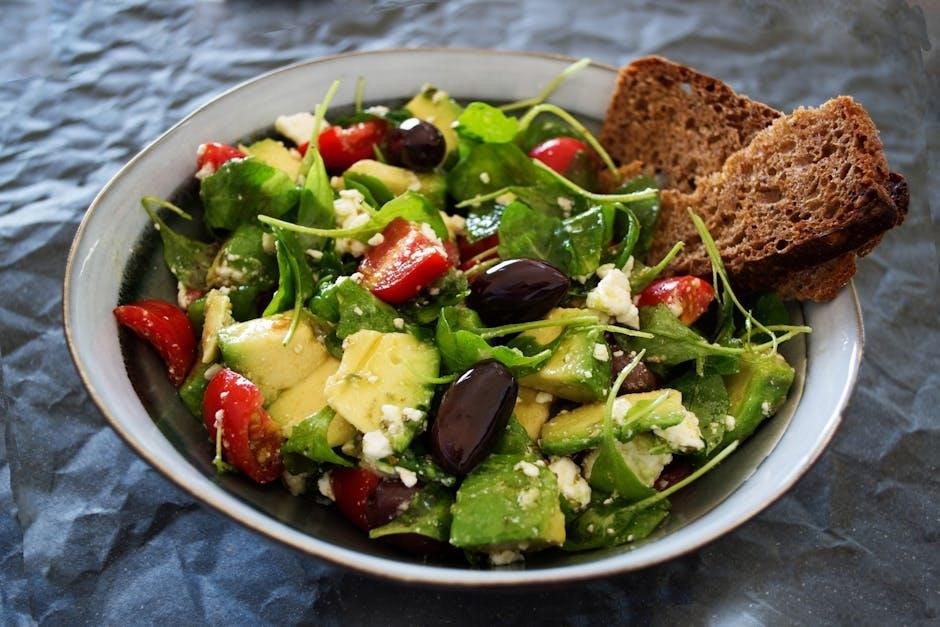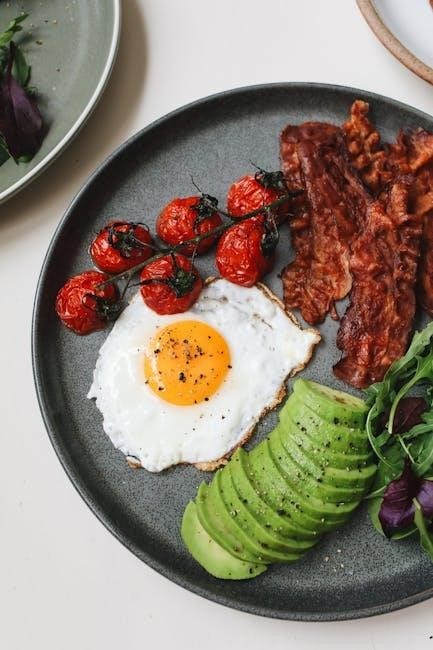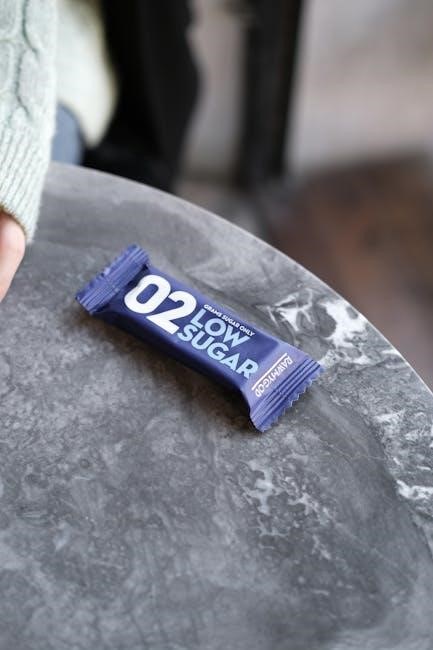A low histamine diet plan is a strategic approach to managing histamine intolerance by eliminating high-histamine foods and focusing on fresh, whole ingredients to reduce symptoms.
What is a Low Histamine Diet?
A low histamine diet is an elimination plan focused on reducing histamine intake to manage intolerance. It emphasizes fresh, whole foods and avoids fermented, aged, or spoiled items. By minimizing histamine-rich foods, the diet aims to alleviate symptoms like digestive issues, skin rashes, or headaches. Proper food preparation and storage are key to maintaining low histamine levels. This approach is often personalized with guidance from a registered dietitian to ensure effectiveness and nutrition balance.
Why Follow a Low Histamine Diet?
Finding a low histamine diet plan PDF can be a game-changer for managing symptoms like skin irritation, digestive issues, and headaches linked to histamine intolerance. By focusing on fresh, whole foods and avoiding high-histamine items, this diet helps reduce bodily histamine levels, offering relief and improving overall well-being. It’s particularly beneficial for those with conditions such as chronic spontaneous urticaria or mast cell activation syndrome. A structured plan ensures nutrition balance while minimizing discomfort, making it a valuable tool for long-term health management.
Who Can Benefit from a Low Histamine Diet?
A low histamine diet plan PDF is ideal for individuals with histamine intolerance, those experiencing symptoms like hives, digestive issues, or headaches, and people with conditions such as mast cell activation syndrome or chronic spontaneous urticaria. It also benefits those with ME/CFS, as high histamine levels can exacerbate fatigue and other symptoms. Additionally, anyone seeking to reduce inflammation or improve digestive health may find this diet beneficial, as it focuses on fresh, whole foods and minimizes histamine-triggering ingredients.

Understanding Histamine Intolerance
Histamine intolerance occurs when the body cannot effectively break down histamine, leading to elevated levels and symptoms like hives, headaches, and digestive issues.
What is Histamine Intolerance?
Histamine intolerance is a condition where the body struggles to break down histamine, a chemical found in certain foods and produced naturally. This occurs due to a deficiency of the enzyme diamine oxidase (DAO), which is responsible for metabolizing histamine. When histamine levels build up, it can trigger a range of symptoms, including hives, headaches, and digestive issues. Managing the condition often involves adopting a low histamine diet to reduce symptoms and improve overall well-being.
Symptoms of Histamine Intolerance
Symptoms of histamine intolerance can vary but often include skin rashes, itching, hives, and flushing. Gastrointestinal issues like bloating, diarrhea, and stomach cramps are common. Some individuals may experience headaches, fatigue, or respiratory discomfort. In severe cases, histamine overload can lead to more serious reactions, such as rapid heartbeat or blood pressure drops. These symptoms occur because the body cannot effectively break down excess histamine, leading to a buildup that triggers allergic-like responses. Managing histamine levels through dietary changes can help alleviate these symptoms.
How Histamine Affects the Body
Histamine is a neurotransmitter that plays a role in immune responses, digestion, and brain function. When histamine levels are too high, it can cause blood vessels to dilate, leading to increased heart rate and blood pressure. Excess histamine can trigger allergic reactions, such as itching, hives, and swelling, and may also affect the digestive system, causing nausea, diarrhea, or stomach cramps. In severe cases, high histamine levels can impact the central nervous system, resulting in headaches, fatigue, or respiratory issues. Balancing histamine levels is crucial for overall well-being.

Foods to Eat on a Low Histamine Diet
Fresh, whole, and unprocessed foods are central to a low histamine diet, emphasizing fruits, vegetables, lean proteins, and whole grains to minimize histamine buildup.
Fresh, Whole, and Unprocessed Foods
Fresh, whole, and unprocessed foods form the foundation of a low histamine diet. These include fresh fruits like apples, berries, and bananas, and vegetables such as leafy greens, carrots, and zucchini. Prioritizing these foods ensures minimal histamine content, as processing and storage can increase histamine levels. Cooking fresh ingredients at home also helps maintain their low histamine status, making them safer for those managing histamine intolerance. This approach supports overall health and reduces symptom triggers effectively.
Low Histamine Protein Sources
Low histamine protein sources are essential for maintaining nutrition on a low histamine diet. Fresh meats like chicken, turkey, and beef are ideal, as they have minimal histamine when consumed fresh. Fish such as cod and trout are also good options, provided they are freshly caught and cooked. Eggs are another excellent low histamine protein source. Avoid processed or aged meats, as these tend to have higher histamine levels. Incorporating these proteins ensures a balanced diet while managing histamine intake effectively.
Low Histamine Fruits and Vegetables
Fresh, whole fruits and vegetables are ideal for a low histamine diet. Apples, mangoes, kiwis, and berries like blueberries and strawberries are excellent choices. Vegetables such as zucchini, carrots, broccoli, and leafy greens like kale and spinach are also low in histamine. Avoid overripe or fermented options, as these can increase histamine levels. Opting for fresh produce helps minimize histamine buildup, making these foods a great addition to your low histamine meal plan.

Foods to Avoid on a Low Histamine Diet
Foods to avoid include fermented items, aged cheeses, cured meats, and high-histamine fruits like citrus and tomatoes. Leftover or spoiled food also contains elevated histamine levels.
High Histamine Foods
High histamine foods include fermented items like cheese, wine, and sauerkraut, as well as cured meats, fish, and certain fruits such as citrus and berries. These foods can trigger histamine intolerance symptoms. Avoiding them is crucial for managing the condition. Freshness matters, as histamine levels rise in aged or spoiled foods. Understanding which foods are high in histamine helps in creating an effective low histamine diet plan to alleviate symptoms and improve overall health.
Fermented Foods to Avoid
Fermented foods are high in histamine and should be avoided on a low histamine diet. Examples include sauerkraut, kimchi, kefir, yogurt, and aged cheeses like cheddar and parmesan. Fermentation increases histamine levels, making these foods unsuitable for those with intolerance. Even small amounts can trigger symptoms like hives or digestive issues. Eliminating fermented foods helps reduce histamine intake, supporting better symptom management and overall health. Always opt for fresh, unprocessed alternatives to maintain a balanced diet.
Other Foods That Trigger Histamine Release
Certain foods beyond high histamine items can trigger histamine release, worsening symptoms. These include citrus fruits, tomatoes, avocados, and processed foods. Spices like cumin and paprika, as well as artificial additives, can also stimulate histamine release. Additionally, alcohol, especially red wine, and foods high in MSG or sulfites should be avoided. Identifying and eliminating these triggers helps reduce histamine-related symptoms, ensuring a more effective low histamine diet plan. Always prioritize fresh, whole foods to minimize histamine release and optimize health benefits.

Sample 7-Day Low Histamine Meal Plan
Our 7-day meal plan offers fresh, histamine-friendly options, including trout, zucchini, and roasted carrots for dinner, ensuring a balanced and symptom-free approach to histamine management.
Breakfast Ideas
Start your day with fresh, histamine-friendly options like a blackberry and rainbow chard smoothie or a pear and kale protein smoothie. Coconut-based dishes, such as coconut pancakes, are also great choices. Opt for fresh fruits like blueberries, bananas, or apples, paired with nuts like almonds or pistachios. Ensure all ingredients are fresh and unprocessed to maintain low histamine levels. These breakfast ideas provide a nutritious and balanced start while adhering to the low histamine diet plan.
Lunch and Dinner Suggestions
For lunch and dinner, consider fresh fish like trout or cod, served with steamed vegetables such as zucchini and carrots. Grilled chicken with new potatoes and broccoli is another excellent option. Incorporate non-nightshade vegetables like leafy greens and avoid high histamine ingredients. Freshly prepared meals ensure lower histamine levels, helping to manage intolerance symptoms effectively. These dishes are both nutritious and flavorful, fitting seamlessly into a low histamine diet plan.
Snack Options
Snacks like fresh blueberries, apples, and bananas are ideal for a low histamine diet. Nuts such as pistachios and coconut-based snacks are also suitable. Carrot sticks with sunflower seed butter or celery paired with almond butter make healthy choices. Fresh fruits like apricots and mangoes are great options too. These snacks are easy to prepare, portable, and help maintain histamine balance throughout the day.

Tips for Implementing a Low Histamine Diet
Plan meals weekly, shop for fresh ingredients regularly, and store food properly to minimize histamine buildup. Cook at home to maintain control over food quality and histamine levels.
Meal Planning and Preparation
Meal planning is essential for a low histamine diet. Create a weekly schedule to ensure fresh, whole foods are prioritized. Shop frequently for fresh ingredients to avoid histamine buildup. Prepare meals in advance using cooking methods like baking or grilling to maintain nutrient quality. Avoid fermented or processed foods, and opt for fresh proteins like wild-caught fish or organic meats. Store leftovers properly to prevent histamine accumulation, and consider freezing meals to maintain freshness. This approach helps minimize symptoms and promotes long-term adherence to the diet.
Shopping for Fresh Ingredients
Shopping for fresh ingredients is crucial for a low histamine diet. Prioritize fresh, whole foods and avoid processed or fermented items. Buy small quantities to ensure ingredients remain fresh and minimize histamine buildup. Opt for organic or locally sourced produce when possible. Fresh vegetables, lean proteins, and low-histamine fruits are ideal choices. Avoid high-risk foods like aged cheeses or cured meats. Regular trips to the market help maintain freshness, and consulting a low histamine diet plan PDF can guide your selections effectively.
Storing Food to Minimize Histamine Buildup
Proper food storage is key to minimizing histamine buildup. Store ingredients in airtight containers and refrigerate promptly to slow histamine production. Freeze meats and fish to preserve freshness, and consume fresh produce within a few days. Avoid keeping leftovers for more than 24 hours, as histamine levels increase over time. Keep fruits and vegetables separate to prevent ripening, which can raise histamine. Regularly clean and organize your fridge to ensure optimal freshness and reduce histamine accumulation in your low histamine diet plan.

Managing Histamine Intolerance Symptoms
Managing histamine intolerance symptoms involves adhering to a low histamine diet, using antihistamines as needed, and making lifestyle changes to reduce histamine triggers effectively.
Reducing Histamine Levels
Reducing histamine levels involves a combination of dietary changes, lifestyle adjustments, and targeted supplements. Following a low histamine diet is crucial, focusing on fresh, whole foods like fruits, vegetables, and lean proteins. Avoiding high histamine triggers such as fermented foods, aged cheeses, and processed meats is essential; Natural remedies like vitamin C and quercetin can help stabilize mast cells and lower histamine. Staying hydrated and managing stress also play key roles in minimizing histamine buildup. Regularly monitoring symptoms and adjusting the diet can lead to significant improvements in overall well-being and histamine management.
Lifestyle Adjustments for Histamine Management
Lifestyle adjustments are vital for managing histamine levels alongside a low histamine diet. Prioritizing fresh food preparation and storing ingredients properly can minimize histamine buildup. Regular physical activity, stress management through mindfulness or yoga, and ensuring adequate sleep are beneficial. Avoiding environmental triggers like temperature extremes and certain chemicals can also help reduce histamine release. By integrating these habits, individuals can better control symptoms and enhance their overall quality of life while adhering to a low histamine diet plan.
Supplements and Natural Remedies
Certain supplements and natural remedies can support histamine management. Quercetin, a natural antihistamine, and vitamin C, which stabilizes mast cells, are often recommended. Probiotics may aid gut health, reducing histamine-related symptoms. Omega-3 fatty acids can help lower inflammation, while DAO enzyme supplements assist in breaking down histamine. Herbal teas like nettle and ginger may also provide relief. Always consult a healthcare professional before starting new supplements to ensure they align with your specific needs and health status.

Creating a Personalized Low Histamine Diet Plan
Consulting a registered dietitian is crucial for tailoring a low histamine diet to individual needs, ensuring optimal nutrition while managing histamine intolerance effectively and safely.
Working with a Registered Dietitian
A registered dietitian specializes in creating personalized low histamine diet plans, ensuring optimal nutrition while addressing histamine intolerance. They assess symptoms, dietary needs, and lifestyle to tailor a plan that minimizes histamine triggers. A dietitian can help identify high-histamine foods, suggest alternatives, and recommend supplements to support histamine metabolism. Regular monitoring and adjustments ensure the plan remains effective and sustainable. Their expertise is invaluable for managing symptoms and achieving long-term health benefits, making them a key partner in your low histamine journey.
Customizing Your Diet Based on Needs
Customizing a low histamine diet involves tailoring food choices to individual tolerance levels and health goals. Fresh, whole foods are emphasized, while high-histamine and fermented items are avoided. Personalization ensures the diet meets nutritional needs and minimizes symptoms. Regular adjustments based on symptom response and lifestyle changes are crucial. This approach helps maintain variety and ensures the diet remains effective and sustainable for long-term health management and well-being.
Tracking Progress and Adjustments
Tracking progress on a low histamine diet involves monitoring symptoms, energy levels, and overall well-being. Keeping a food diary helps identify triggers and patterns, enabling informed adjustments. Regularly reviewing meal plans ensures they remain balanced and effective. Adjustments may include introducing new foods, modifying portion sizes, or exploring alternative recipes. Consulting with a healthcare professional or dietitian can provide personalized insights and support. Continuous monitoring allows for a dynamic approach, ensuring the diet evolves to meet changing needs and health goals effectively.

Low Histamine Diet Recipes
Discover delicious and easy-to-follow recipes tailored for a low histamine diet, including smoothies, snacks, and meals made with fresh, whole ingredients for optimal health.
Breakfast Recipes
Start your day with fresh, histamine-friendly breakfast options like smoothies made with coconut, berries, and leafy greens. Try omelets with spinach and zucchini or chia pudding with fresh fruits. Incorporate gluten-free oats for a hearty porridge. Ensure ingredients are fresh and organic to minimize histamine levels. Avoid fermented or aged foods, opting instead for newly cooked meals. These recipes are designed to be simple, nutritious, and gentle on your system, helping you maintain a balanced low histamine diet. Experiment with flavors to keep your mornings enjoyable and varied.
Lunch and Dinner Recipes
For lunch and dinner, focus on fresh, histamine-friendly proteins like grilled trout or cod, paired with roasted non-nightshade vegetables such as zucchini or carrots. Chicken dishes with new potatoes and broccoli are also excellent options. Incorporate quinoa or sweet potatoes for complex carbs. Salads with cucumber, celery, and fresh herbs, dressed with olive oil and lemon, make light yet satisfying meals. Avoid high-histamine ingredients and ensure all foods are freshly prepared to keep histamine levels low. Customize recipes to suit your dietary needs while maintaining balance and flavor.
Snack and Dessert Recipes
Snacks and desserts on a low histamine diet can be delicious and nutritious. Opt for fresh fruits like apples, bananas, and blueberries, or enjoy nuts such as pistachios. For desserts, try coconut-based treats or fruit salads with low histamine options like mango and peaches. Smoothies made with histamine-friendly ingredients like kale, pear, and coconut are also ideal. Ensure all ingredients are fresh and avoid any fermented or high histamine additives to maintain symptom relief and dietary balance.

Monitoring and Maintaining a Low Histamine Diet
Consistently tracking your histamine intake and bodily reactions is key to long-term success. Regular health check-ups and maintaining a food diary can help identify triggers and monitor progress effectively.
Regular Health Check-Ups
Regular health check-ups are essential for monitoring the effectiveness of a low histamine diet. They help assess symptom improvement and ensure proper nutrient levels. A healthcare provider can adjust the diet plan based on progress, addressing any deficiencies or persistent issues. These check-ups also provide an opportunity to discuss challenges and receive personalized advice, ensuring long-term well-being and optimal histamine management.
Keeping a Food Diary
Keeping a food diary is a valuable tool for managing a low histamine diet. By tracking daily food intake and symptoms, individuals can identify trigger foods and monitor progress. Note portion sizes, preparation methods, and any reactions. This helps pinpoint histamine-related issues and refine the diet plan. Regularly reviewing the diary with a healthcare provider or dietitian ensures personalized adjustments and better symptom control. It also fosters accountability and helps maintain long-term adherence to the low histamine lifestyle.
Long-Term Benefits of a Low Histamine Diet
A low histamine diet offers numerous long-term benefits, including reduced inflammation, improved digestion, and enhanced overall well-being. By eliminating high-histamine foods, individuals often experience fewer allergic reactions, clearer skin, and relief from chronic symptoms like headaches or bloating. Over time, this dietary approach can lead to better energy levels, reduced susceptibility to illnesses, and a more balanced immune response. Consistency is key to achieving and maintaining these benefits, making a low histamine diet a sustainable choice for long-term health.